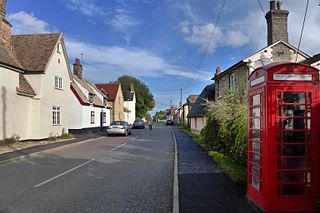
Orwell is a rural village outside Cambridge in South Cambridgeshire, England.
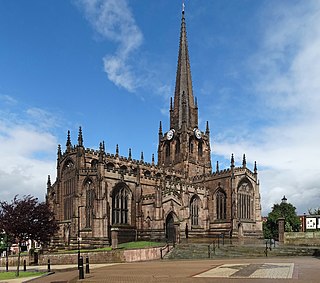
The Minster Church of All Saints or Rotherham Minster is the Anglican minster church of Rotherham, South Yorkshire, England. The Minster is a prominent example of Perpendicular Gothic architecture and various architectural historians have rated it highly. Nikolaus Pevsner describes it as "one of the largest and stateliest churches in Yorkshire", Simon Jenkins states it is "the best work in the county", and Alec Clifton-Taylor calls it the "glory of Rotherham". With its tall spire, it is Rotherham's most predominant landmark, and amongst the tallest churches in Yorkshire.
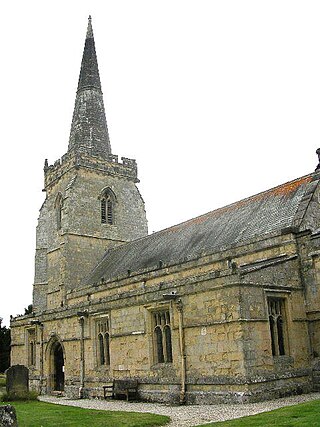
St Peter's Church is a redundant Anglican church in the village of Wintringham, North Yorkshire, England. It is recorded in the National Heritage List for England as a designated Grade I listed building, and is under the care of the Churches Conservation Trust. The architectural historian Nikolaus Pevsner described the building as "the most rewarding church in the East Riding with an exceptional collection of furnishings".

St Mary's Church in the village of Purton in north Wiltshire, England, is an active Church of England parish church in the Diocese of Bristol. A large building begun in the 13th century and one of only three churches in England to have both a western tower and a central spire, it has been designated as a Grade I listed building by English Heritage.

St Peter's Church is a redundant Anglican church in the village of Offord D'Arcy, Cambridgeshire, England. It is recorded in the National Heritage List for England as a designated Grade I listed building, and is under the care of the Churches Conservation Trust. The church stands adjacent to the East Coast Main Railway Line, overlooking the River Great Ouse.

St John's Church is a redundant Anglican church in the village of Duxford, Cambridgeshire, England. In 1967 it was recorded in the National Heritage List for England as a designated Grade I listed building, and is now vested in The Churches Conservation Trust. The church stands on the junction of St John's Street and Green Street and is open daily to visitors.
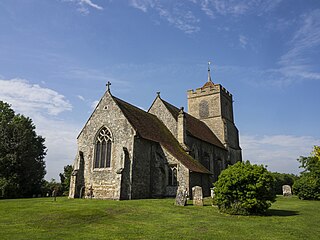
St Andrew's Church is a redundant Anglican church in the village of Buckland, Hertfordshire, England. It is recorded in the National Heritage List for England as a designated Grade II* listed building, and is under the care of the Churches Conservation Trust. The church stands at the highest point in the village to the east of Ermine Street, now the A10 road, between Royston and Buntingford.

Old St Peter and St Paul's Church is a former Anglican church near the village of Albury, Surrey, England in the care of The Churches Conservation Trust. It is recorded in the National Heritage List for England as a designated Grade I listed building. The church stands in Albury Park, to the northwest of Albury Hall, and between the villages of Albury and Shere.

St Mary Magdalene's Church is located in Church Street, Clitheroe, Lancashire, England. It is the Anglican parish church of the town, and is in the deanery of Whalley, the archdeaconry of Blackburn, and the diocese of Blackburn. The church, dedicated to Jesus' companion Mary Magdalene, is recorded in the National Heritage List for England as a designated Grade II* listed building.

The Church of St Andrew is a Grade I listed church in the village of Clifton Campville, Staffordshire. It was built in the 13th and 14th centuries. The tall spire is a notable feature, visible from a great distance.

St Michael's Church is in Church Lane, Aughton, Lancashire, England. It is an active Anglican parish church in the deanery of Ormskirk, the archdeaconry of Wigan & West Lancashire, and the diocese of Liverpool. Its benefice is united with that of Holy Trinity, Bickerstaffe. The church is recorded in the National Heritage List for England as a designated Grade I listed building.

St Lawrence's Church is in the village of Morland, Cumbria, England. It is an active Anglican parish church in the deanery of Appleby, the archdeaconry of Carlisle, and the diocese of Carlisle. The parish of Morland includes the historic parish of Thrimby, with its church of St Mary, Little Strickland. The benefice of Morland is united, under the name North Westmorland, with the parishes of Askham and Lowther, Bampton, Bolton, Cliburn, Clifton and Brougham, Crosby Ravensworth, Shap and Great Strickland. The church is recorded in the National Heritage List for England as a designated Grade I listed building. It has the only Anglo-Saxon tower in Cumbria.
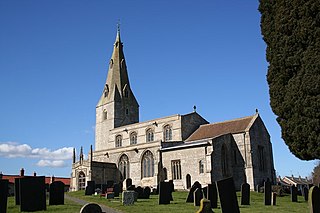
St Peter's Church is a Grade I listed Anglican parish church dedicated to Saint Peter, in Ropsley, Lincolnshire, England. The church is 5 miles (8 km) east from Grantham, and in the South Kesteven Lincolnshire Vales. St Peter's is in the ecclesiastical parish of Ropsley, and is part of the North Beltisloe Group of churches in the Deanery of Beltisloe, and the Diocese of Lincoln.

St Andrew's Church is a Grade I listed Anglican parish church dedicated to Andrew the Apostle, in Billingborough, Lincolnshire, England. The church is 7 miles (11 km) south-east from Sleaford, and at the western edge of the Lincolnshire Fenlands.

The Church of St John the Evangelist is a Grade I listed Church of England parish church dedicated to John the Evangelist, in Corby Glen, Lincolnshire, England. The church is 9 miles (14 km) south-east of Grantham, and in the South Kesteven Lincolnshire Vales. It is noted in particular for its 14th- and 15th-century medieval wall paintings.

St Mary Magdalene Church is the Church of England parish church in the village of Ickleton in Cambridgeshire. The church is a Grade I listed building. Its parish is part of a combined benefice with those of St Peter's, Duxford and SS Mary and John, Hinxton.

The Church of St Thomas à Becket, Ramsey is the Church of England parish church of Ramsey, Cambridgeshire. The parish is part of a benefice that includes also the parish of Upwood with Great and Little Raveley.
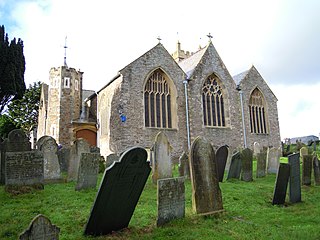
The Church of the Holy Trinity is the Anglican parish church for Ilfracombe in Devon. The building has been a Grade I listed building since 1951 and comes under the Diocese of Exeter.

Chesterton Tower is a Grade I listed medieval tower located in Chapel Street, Chesterton, Cambridge. The two-storey 14th-century tower is the former residence of Italian procurators of the abbot of Vercelli in Italy. It stands in the former vicarage garden of nearby St Andrew's Church, Chesterton. Built from field stones, clunch, brick and ashlar quoins, the tower is, unusually, not a fragment but a complete dwelling with vaulted ceilings, a spiral staircase and garderobe. The lower storey is vaulted in two bays with chamfered ribs and carved bosses. A restoration was completed in 1949.

The Church of the Holy and Undivided Trinity, more commonly known as Trinity Church, is the main Church of England parish church for the market town of Ossett, West Yorkshire, England. Located on plateau some 300 feet (91 m) above sea level, the church's 226 feet high spire is a local landmark, making the church amongst the tallest in the country. Built from 1862 to 1865 in the Gothic Revival style, the church has been designated a Grade II* listed building since 1988 by Historic England.





















